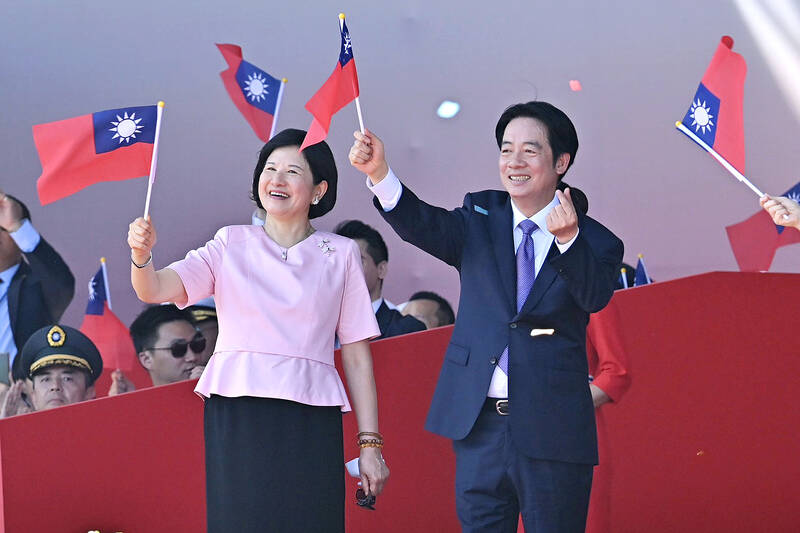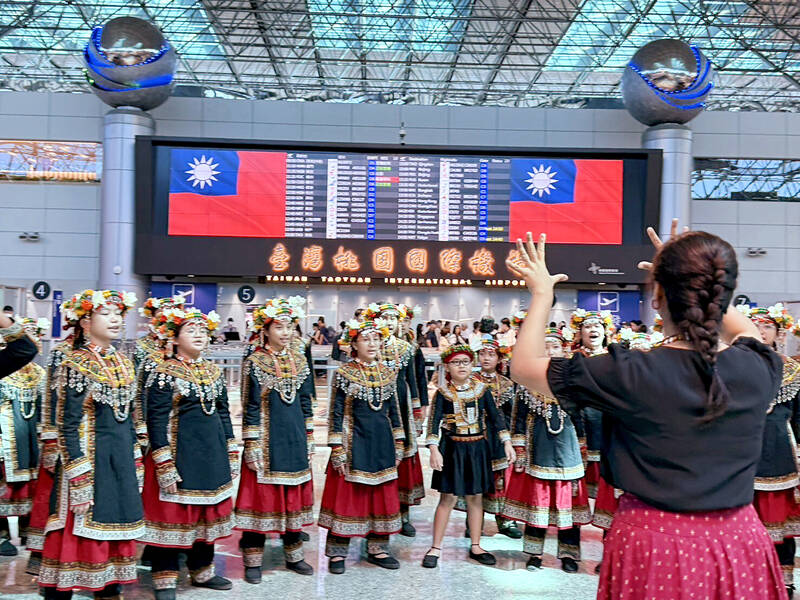The defense goals stated by President William Lai (賴清德) in his National Day address are closely linked to the layout of the nation’s economic strategy, a source said yesterday on condition of anonymity.
Lai said in his speech that the government aims to achieve three major goals through a new special defense budget: the implementation of the T-Dome, a system of layered defense with a highly sensitive anti-air system for effective missile interception that would protect the lives and properties of the Taiwanese public; the continued introduction of new technologies to be used in tandem with artificial intelligence to create a smart defense system that would maximize the deterrence factor of Taiwan’s asymmetrical strategy; and continued investments in innovative defense technologies.
These goals would not only enable greater autonomy for the domestic defense sector, enhance the nation’s asymmetrical combat capabilities and solidify the foundations of the domestic defense industry, but would also help Taiwan work with like-minded nations on the international stage to form a joint line of defense for freedom and democracy, further bolstering Taiwan’s strategic position, the source said.

Photo: Tu Chien-jung, Taipei Times
The national defense budget is not only concerned with defense, but also with building up domestic capabilities by bolstering the national defense industry, the source said, adding that in this sense, the national defense budget could also be seen as the economic budget.
Domestic and autonomous research and development of design and manufacturing capabilities, and the growth of the local supply chain would accelerate the upgrading and transitioning of basic industrial sectors into providers for the defense industry, the source said.
By extension, the younger generation would have more opportunities to work in start-ups, high-tech, and the artificial intelligence research and development sectors, they said.

Photo courtesy of Taoyuan International Airport Corp
Lai’s speech about the special defense budget and the T-Dome project was not a spontaneous move, they added.
In an opinion piece published by Foreign Affairs magazine on Thursday, National Security Council Deputy Secretary-General Lin Fei-fan (林飛帆) wrote that “peace cannot be secured through appeasement” and urged democratic countries to work together.
This ties in with the president’s talking points that “strength is not just expressed through military might, but also through whole-of-society resilience,” and that “the whole society participates ... helping ourselves so that we can help others,” the source said.
Meanwhile, a national security official said Lai’s de-emphasis on cross-strait relations in this year’s speech allowed him to deliver a brisker narrative on Taiwan’s critical position on the international stage, emphasizing that “the common ground between democratic Taiwan and authoritarian China should be the joint pursuit of peace.”
Unlike before, the president did not repeat the phrase “Taiwan and China are not subordinate to each other,” as “Taiwan” is already the “greatest consensus in Taiwanese society,” with the nation sticking to the “four commitments” and “four pillars of peace” plan, the official said on condition of anonymity.
The “four commitments,” touted by then-president Tsai Ing-wen (蔡英文) in her National Day address in 2021, state that the Taiwanese government and its people “are committed to maintaining a free and democratic constitutional system, ensuring that the Republic of China and the People’s Republic of China will not be subordinate to each other, resisting annexation or encroachment upon Taiwan’s sovereignty, and guaranteeing that the future of the Republic of China is decided by the will of Taiwanese.”
Lai’s “four pillars” for preserving peace in the Taiwan Strait are to continue building Taiwan’s defense capabilities, enhancing economic security, deepening democratic partnerships, and facilitating cross-strait dialogue and exchanges.
Lai’s cross-strait discourse, which began with a mention of the 80th anniversary of the end of World War II, centered on peace, the official said.
It highlights three points: First, that Taiwan’s critical position on the international stage should be the hub of peace and stability in the Indo-Pacific region, the official said.
Second is the president’s call to China to live up to its responsibility as a major power, and third, that Taiwan will strengthen its capabilities to protect and uphold peace, the official added.
The central theme of peace stems from the G7 communique of 2024, which states: “We reaffirm that maintaining peace and stability across the Taiwan Strait is indispensable to international security and prosperity,” the official said.
Peace is not only just the core foundation of Lai’s cross-strait policy, but also the common consensus of the international community, the official said.

Taiwanese scientists have engineered plants that can capture about 50 percent more carbon dioxide and produce more than twice as many seeds as unmodified plants, a breakthrough they hope could one day help mitigate global warming and grow more food staples such as rice. If applied to major food crops, the new system could cut carbon emissions and raise yields “without additional equipment or labor costs,” Academia Sinica researcher and lead author the study Lu Kuan-jen (呂冠箴) said. Academia Sinica president James Liao (廖俊智) said that as humans emit 9.6 billion tonnes of carbon dioxide compared with the 220 billion tonnes absorbed

The Taipei Mass Rapid Transit (MRT) Wanda-Zhonghe Line is 81.7 percent complete, with public opening targeted for the end of 2027, New Taipei City Mayor Hou You-yi (侯友宜) said today. Surrounding roads are to be open to the public by the end of next year, Hou said during an inspection of construction progress. The 9.5km line, featuring nine underground stations and one depot, is expected to connect Chiang Kai-shek Memorial Hall Station to Chukuang Station in New Taipei City’s Jhonghe District (中和). All 18 tunnels for the line are complete, while the main structures of the stations and depot are mostly finished, he

Taipei is to implement widespread road closures around Taipei 101 on Friday to make way for large crowds during the Double Ten National Day celebration, the Taipei Department of Transportation said. A four-minute fireworks display is to be launched from the skyscraper, along with a performance by 500 drones flying in formation above the nearby Nanshan A21 site, starting at 10pm. Vehicle restrictions would occur in phases, they said. From 5pm to 9pm, inner lanes of Songshou Road between Taipei City Hall and Taipei 101 are to be closed, with only the outer lanes remaining open. Between 9pm and 9:40pm, the section is

China’s plan to deploy a new hypersonic ballistic missile at a Chinese People’s Liberation Army Rocket Force (PLARF) base near Taiwan likely targets US airbases and ships in the western Pacific, but it would also present new threats to Taiwan, defense experts said. The New York Times — citing a US Department of Defense report from last year on China’s military power — on Monday reported in an article titled “The missiles threatening Taiwan” that China has stockpiled 3,500 missiles, 1.5 times more than four years earlier. Although it is unclear how many of those missiles were targeting Taiwan, the newspaper reported